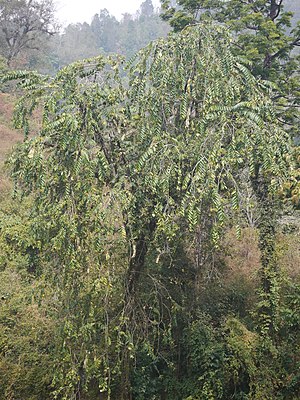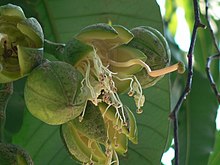Duabanga grandiflora
| Duabanga grandiflora | ||||||||||||
|---|---|---|---|---|---|---|---|---|---|---|---|---|

Duabanga grandiflora |
||||||||||||
| Systematics | ||||||||||||
|
||||||||||||
| Scientific name | ||||||||||||
| Duabanga grandiflora | ||||||||||||
| ( Roxb. Ex DC. ) Walp. |
Duabanga grandiflora is a tree in the loosestrife family from eastern India to Southeast Asia and southwest China .
description
Duabanga grandiflora grows as an evergreen tree to over 30 meters high. The trunk diameter reaches up to 2 meters. The gray-brown bark is scaly with age.
The simple, short-stalked and bare, slightly leathery leaves are opposite. The short petiole is up to 0.8-1.2 inches long. The entire-edged, acuminate to pointed, underside lighter leaves are 10-27 centimeters long and 4-10 centimeters wide. They are ovate, lanceolate to oblong and the base is rounded to slightly heart-shaped. The nerve is pinnate with many side veins and raised on the underside. There are very small stipules .
Terminal, more or less hanging panicles are formed. The greenish-white and fragrant, large flowers sit on a thick, 3–4 cm long stem. The leathery, thick and fleshy, greenish 4–7 sepals are up to 3 centimeters long, triangular and short, broadly cup-shaped. The 6–7 white, obovate petals are up to 4 inches long. There are many (50) and long, free stamens , with thread-like, white stamens and movable anthers, in two circles. The multi-chambered ovary is semi-protruding with a long and thick stylus with a heady, lobed and green stigma . The flowers open at night.
It forms 3–4.5 centimeters, hemispherical, multi-lobed and many-seeded, dark brown, leathery capsule fruits with a persistent, dry calyx. The many, small, flat seeds are tailed on both sides and about 4–5 millimeters long.
Taxonomy
The first description of Basionyms Lagerstroemia grandiflora was made in 1826 by de Candolle Augustin-Pyrame by William Roxburgh in Mém. Soc. Phys. Genève 3 (2): 84. The division into the genus Duabanga took place in 1843 by Wilhelm Gerhard Walpers in Repert. Bot. Syst. 2: 114. Another synonym is Duabanga sonneratioides Buch.-Ham.
use
The young, sour fruits are eaten raw or cooked.
The medium-heavy, non-durable wood is used for some applications. It is known as Duabanga .
literature
- K. Kubitzki : The Families and Genera of Vascular Plants. Vol.IX : Flowering Plants Eudicots , Springer, 2007, ISBN 3-540-32214-0 . P. 238.
- PJA Kessler, Hoang Van Sam, Khamseng Nanthavong: Trees of Laos and Vietnam: A Field Guide to 100 Economically or Ecologically Important Species. In: Blumea. 49 (2-3), 2004, pp. 201-349, doi: 10.3767 / 000651904X484298 .
- Martin Chudnoff: Tropical Timbers of the World. Agriculture Handbook 607, USDA Forest Service, 1984, p. 337, limited preview in Google Book Search.
- J. Gérard, D. Guibal, S. Paradis, J.-C. Cerre: Tropical Timber Atlas. Éditions Quæ, 2017, ISBN 978-2-7592-2798-3 , pp. 288 ff, limited preview in the Google book search.
Web links
- Duabanga grandiflora at asianplant.net.
- Duabanga grandiflora at Useful Tropical Plants.

